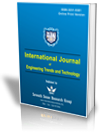Calibration of Shetrunji River Basin Using SUFI-2 Algorithm in SWATCUP
Calibration of Shetrunji River Basin Using SUFI-2 Algorithm in SWATCUP |
||
 |
 |
|
| © 2025 by IJETT Journal | ||
| Volume-73 Issue-4 |
||
| Year of Publication : 2025 | ||
| Author : Zarna J. Chovatiya, Gargi Rajapara, Zuned M. Shaikh |
||
| DOI : 10.14445/22315381/IJETT-V73I4P105 | ||
How to Cite?
Zarna J. Chovatiya, Gargi Rajapara, Zuned M. Shaikh, "Calibration of Shetrunji River Basin Using SUFI-2 Algorithm in SWATCUP," International Journal of Engineering Trends and Technology, vol. 73, no. 4, pp. .44-55, 2025. Crossref, https://doi.org/10.14445/22315381/IJETT-V73I4P105
Abstract
Modern times have found a way to overcome the laborious and time-consuming manual methods of performing modelling on physically based models. This work is also a depiction of such a method that incorporates the automatic calibration technique using “SWATCUP (Soil Water Assessment Tools Calibration Uncertainties Program)” which is available in the public domain. This work is a later part of the hydrological modelling, which was done in ArcGIS and interfaced with SWAT 2012. Out of many programs available, one of the most renowned algorithms known as SUFI-2 (Sequential Uncertainty Fitting version 2) is used for the calibration. The demonstration is done on one of the major tributaries of Western India famously known as Shetrunji River, Gujarat, India. The model calibration was carried out from 2012 to 2015 on a monthly basis using the observed data fetched from local government agencies and IMD (Indian Meteorological Department). With numerous permutations and combinations of trials, the results obtained are found to be pretty promising. The co-relations obtained from the trials show satisfactory outcomes with an R2 value of 0.81 and an NSE (Nash Sutcliffe Efficiency) of 0.79. The study can further be taken to other watersheds having similar features.
Keywords
SUFI-2, SWATCUP, Calibration, Validation, Nash Sutcliffe Efficiency.
References
[1] J. Jasmine, and Rohan S. Gurav, “SWAT Model Calibration, Validation and Parameter Sensitivity Analysis Using SWAT-CUP,” Journal of Remote Sensing, Environmental Science & Geotechnical Engineering, vol. 6, no. 1, pp. 31-46, 2021.
[Google Scholar] [Publisher Link]
[2] Zhang Yinhui, “Development of Study on Model-SWAT and its Application,” Progress in Geography, vol. 24, no. 5, pp. 121-130, 2005.
[CrossRef] [Google Scholar] [Publisher Link]
[3] Quanchong Su et al., “Runoff Simulation and Climate Change Analysis in Hulan River Basin Based on SWAT Model,” Water, vol. 15, no. 15, pp. 1-14, 2023.
[CrossRef] [Google Scholar] [Publisher Link]
[4] Céline Conan, “A Long-Term Hydrological Modelling of the Upper Guadiana River Basin (Spain),” Journal of Physics and Chemistry of the Earth, vol. 28, no. 4-5, pp. 193-200, 2003.
[CrossRef] [Google Scholar] [Publisher Link]
[5] Fayera Gudu Tufa, and Chala Hailu Sime, “Stream Flow Modeling Using SWAT Model and the Model Performance Evaluation in Toba Sub‑Watershed, Ethiopia,” Modeling Earth Systems and Environment, vol. 7, no. 4, pp. 2653-2665, 2021.
[CrossRef] [Google Scholar] [Publisher Link]
[6] Seyed Hashem Hosseini, and Mohammad Reza Khaleghi, “Application of SWAT Model and SWAT‑CUP Software in Simulation and Analysis of Sediment Uncertainty in Arid and Semi‑Arid Watersheds (Case Study: The Zoshk-Abardeh Watershed),” Modeling Earth Systems and Environment, vol. 6, no. 4, pp. 2003-2013, 2020.
[CrossRef] [Google Scholar] [Publisher Link]
[7] Nirmal Kumar et al., “SWAT Model Calibration and Uncertainty Analysis for Streamflow Prediction of the Tons River Basin, India, using Sequential Uncertainty Fitting (SUFI-2) Algorithm,” Modeling Earth Systems and Environment, vol. 3, no. 1, pp. 1-13, 2017.
[CrossRef] [Google Scholar] [Publisher Link]
[8] Swatantra Kumar Dubey et al., “Hydroclimatic Impact Assessment Using the SWAT Model in India-State of the Art Review,” Sustainability, vol. 15, no. 22, pp. 1-40, 2023.
[CrossRef] [Google Scholar] [Publisher Link]
[9] Taha Aawar, and Deepak Khare, “Assessment of Climate Change Impacts on Streamflow through Hydrological Model Using SWAT Model: A Case Study of Afghanistan,” Modeling Earth Systems and Environment, vol. 6, no. 3, pp. 1427-1437, 2020.
[CrossRef] [Google Scholar] [Publisher Link]
[10] Nasrin Zalaki-Badi et al., “Calibration and Uncertainty of the SWAT Model Using the SUFI-2 Algorithm,” International Journal of Research Studies in Science, Engineering and Technology, vol. 5, no. 4, pp. 4-10, 2018.
[Google Scholar] [Publisher Link]
[11] V. Tejaswini, and K.K. Sathian, “Calibration and Validation of Swat Model for Kunthipuzha Basin Using SUFI-2 Algorithm,” International Journal of Current Microbiology and Applied Sciences, vol.7, no. 1, pp. 2162-2172, 2018.
[CrossRef] [Google Scholar] [Publisher Link]
[12] K. Eckhardt, and J.G. Arnold, “Automatic Calibration of a Distributed Catchment Model,” Journal of Hydrology, vol. 251, no. 1-2, pp. 103-109, 2001.
[CrossRef] [Google Scholar] [Publisher Link]
[13] Karim C. Abbaspour et al., “Modelling Hydrology and Water Quality in the Pre-Alpine/Alpine Thur Watershed Using SWAT,” Journal of Hydrology, vol. 333, no. 2-4, pp. 413-430, 2007.
[CrossRef] [Google Scholar] [Publisher Link]
[14] A.R. Senthil Kumar et al., “Hydrological Modelling of Bhagirathi Basin up to Tehri Dam using SWAT,” Roorkee Water Conclave, pp. 1-16, 2020.
[Google Scholar] [Publisher Link]
[15] Sarika Wandre, Harji Damji Rank, and Vinayak Shinde, “Prioritization of Watersheds of Shetrunji River Basin Based on Morphometric Analysis Using Remote Sensing and GIS,” Multilogic in Science: An International Refereed, Peer Reviewed & Indexed Quarterly Journal, vol. 4, no. 12, pp. 24-30, 2015.
[Google Scholar] [Publisher Link]
[16] Mohdzuned Mohmedraffi Shaikh, Pradeep P. Lodha, and Saeid Eslamian, “Automatic Calibration of SWAT Hydrological Model by SUFI-2 Algorithm,” International Journal of Hydrology Science and Technology, vol. 13, no. 3, pp. 324-334, 2022.
[CrossRef] [Google Scholar] [Publisher Link]
[17] Khairi Khalid et al., “Sensitivity Analysis in Watershed Model Using SUFI-2 Algorithm,” Procedia Engineering, vol. 162, pp. 441-447, 2016.
[CrossRef] [Google Scholar] [Publisher Link]
[18] S.L. Neitsch et al., “Soil and Water Assessment Tool Theoretical Documentation Version 2005,” Texas Water Resources Institute: Temple, Report, TX, USA, pp. 1-476, 2005.
[Publisher Link]
[19] Youen Grusson et al., “Assessing the Capability of the SWAT Model to Simulate Snow, Snow Melt and Stream Flow Dynamics Over an Alpine Watershed,” Journal of Hydrology, vol. 531, no. 3, pp. 574-588, 2015.
[CrossRef] [Google Scholar] [Publisher Link]
[20] J.E. Nash, and J.V. Sutcliffe, “River Flow Forecasting through Conceptual Models: Part I-A Discussion of Principles,” Journal of Hydrology, vol.10, no. 3, pp. 282-290.1970.
[CrossRef] [Google Scholar] [Publisher Link]
[21] E. Taghvaye Salimi et al., “Runoff Simulation Using SWAT Model and SUFI-2 Algorithm (Case Study: Shafaroud Watershed, Guilan Province, Iran),” Caspian Journal of Environmental Sciences, vol. 14, no. 1, pp. 69-80, 2016.
[Google Scholar] [Publisher Link]
[22] Sahita I. Waikhom et al., “Impact Assessment of Land Use/Land Cover Changes on Surface Runoff Characteristics in the Shetrunji River Basin using the SWAT Model,” Water Practice & Technology, vol. 18, no. 5, pp. 1221-1232, 2023.
[CrossRef] [Google Scholar] [Publisher Link]

